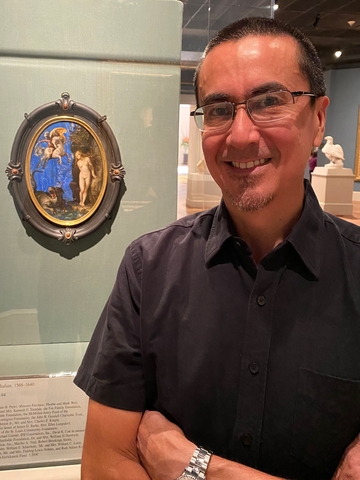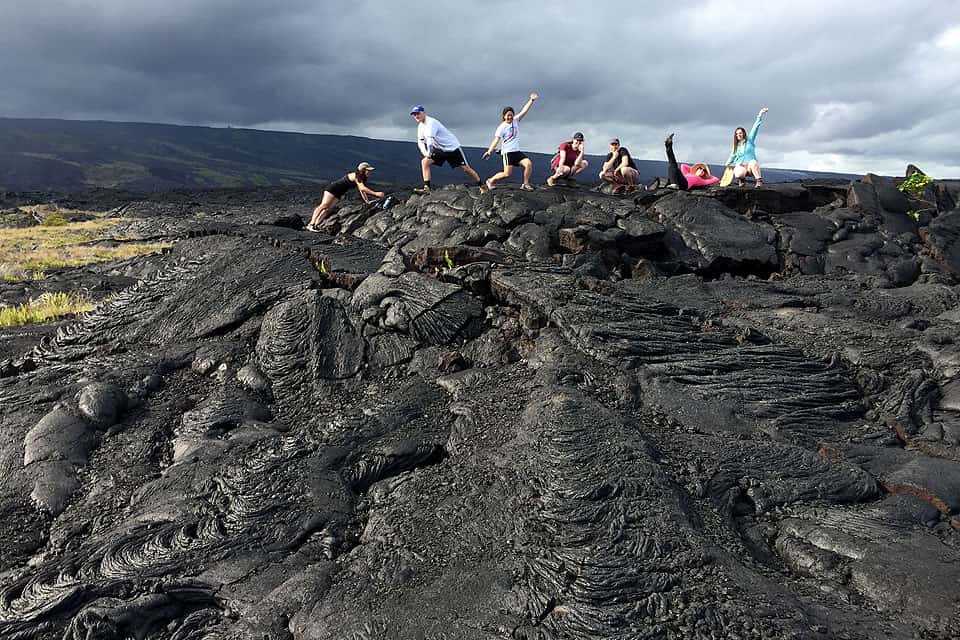Painting of a Man Climbing Volcano St Louis Art Museum
eleven/05/2020
Some of the globe's earliest masterpieces were painted on stones, and now John Encarnacion, Ph.D., a geologist at Saint Louis University, is combining his passions for science and the fine arts to assistance art lovers get a sense of ways geology hides in museum masterpieces.

"I wanted to be a painter, believe it or non," he said. "But I was also very curious and loved to be outdoors. That is why I somewhen took on geology. Only I never abandoned my love for art."
Encarnacion recently contributed to the itemize of a forthcoming exhibition at the St. Louis Art Museum (SLAM), Paintings on Stone: Scientific discipline and the Sacred, 1530-1800. The exhibition is tentatively ready to open in 2022, Encarnacion said.
"SLU encourages united states of america to seek ways to serve our community," he said. "The diverse segments of that community—the art and scientific discipline sectors in this instance—benefit when at that place is mutual cooperation, sharing of ideas, and advice."
When the exhibit opens, Encarnacion, a professor in the Department of World and Atmospheric Sciences in the College of Arts and Sciences, will evangelize several lectures at SLAM to explain the origins of the stones and reply questions from the public.
An Artist's Eye Meets Science's Quest to Empathise Earth'southward Rocky Origins
As it prepared the itemize, SLAM needed an expert to aid with the stone identifications and descriptions. According to Encarnacion, the museum reached out to the St. Louis Science Eye for aid, and its staff directed the museum to him. He helped with identifying stones in the showroom and then turned to writing sections about each blazon.
"Because the paintings often contain natural features in the stone every bit part of the painting, I needed to make certain to describe what those features are and how they formed," Encarnacion explained. "For case, there might be billowy layered structures in the stone that appear as clouds in the painting. It was challenging to depict the origins of sometimes circuitous structures in the stone for the lay person without being too technical."
Instruction a Passion for Geology, Stone by Stone, By Way of the Arts
As director of SLU'southward undergraduate geoscience plan, Encarnacion studies tectonic and petrologic problems dealing with subduction, magmatism, island arc and continental crustal growth and ore deposits.
Acquire how Encarnacion and his colleagues linked a dam's development to earthquakes
His work has taken him to Antarctica, China, Republic of iceland, Madagascar, the Philippines and southern Africa. He also leads students into the field on research trips to geological must-see locations like Hawaii, California's Death Valley and Mount St. Helen's and Mount Rainier in Washington State.
Read more well-nigh some of Encarnacion's past inquiry
"Science is increasingly more important in our daily lives, especially earth science," he said. "Our continually developing modern technologies rely on materials derived from the earth and found past geologists. Extremely important bug like climate change and environmental degradation need insertion in conversation whenever politely possible."
While his research usually takes him out to written report rock formations, Encarnacion has never abandoned an early on love of fine art and sees interdisciplinary connections between the two, historically and in daily life today. Before embarking on his own career as a geologist, Encarnacion considered majoring in the fine arts.
"Leonardo Da Vinci was an astute observer of landscapes, stone formations, and fossils," the SLU geologist said. "His detailed observations of geologic features enhanced his paintings and made them more than realistic. The artists that used stones as a canvas for their paintings in this book noticed and appreciated the interesting patterns in stones, which presumably inspired them to create their art."
"Conversely, i tin can be a better geologist if i develops an eye for patterns, subtleties in color and shade, and skills in drawing iii dimensional objects—a common challenge for field geologists," he continued.
Encarnacion said he realized early in his career that creative power tin exist beneficial in geology.
"I discovered that one is a ameliorate geologist if ane tin draw things well," he continued. "Geology is very visual. The World has cute structures expressed in landscapes, rock formations, and structures seen in a roadcut, say. Drawing these features forces you to think about the details of the features you are observing. I use my drawing skills on the chalkboard in the classroom. I beloved to tell my students 'OK, it's cartoon time again!'"
His Favorite Slice in the Upcoming Showroom?
Encarnacion recommends those going to see the SLAM exhibit await for the pieces which use lapis lazuli (lapis for curt) every bit their canvas, including Perseus Rescuing Andromeda by D'Arpino.
"Lapis lazuli is a brilliant, almost unnatural, blueish with sprinklings of vivid xanthous pyrite and streaks of white calcite," he said. "I love the manner the artists used the lapis as surreal-looking skies."
Founded in 1818, Saint Louis University is ane of the nation'due south oldest and most prestigious Catholic institutions. Rooted in Jesuit values and its pioneering history as the first university west of the Mississippi River, SLU offers nigh 13,000 students a rigorous, transformative education of the whole person. At the core of the Academy'southward diverse customs of scholars is SLU's service-focused mission, which challenges and prepares students to brand the world a better, more just place.
Story by Amelia Flood, Academy Marketing and Communications.
Source: https://www.slu.edu/news/2020/november/encarnacion-paintings-on-stone.php

0 Response to "Painting of a Man Climbing Volcano St Louis Art Museum"
ارسال یک نظر